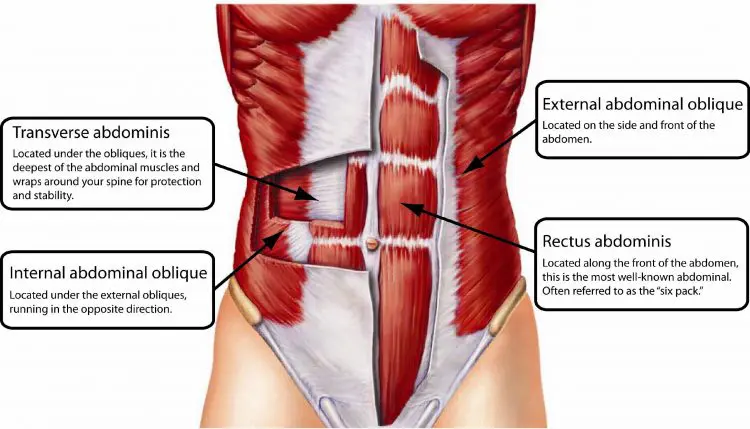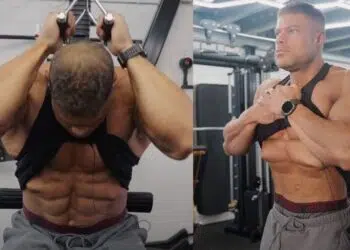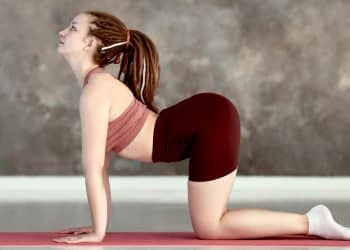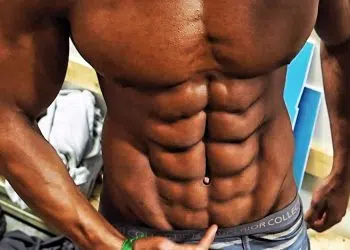Without a doubt, the lower abs are one of the most common “problem areas” that exercisers want to improve. Getting the upper abs to pop is not usually too difficult, and many gymgoers have respectable four-packs.
Unfortunately, losing fat from the lower abdomen can be tricky, and the lower abs are harder to develop, making full six and eight-pack abs much more challenging to achieve.
This is in part due to the structure of the abdominal muscles and where your body is genetically programmed to store fat. Some people store fat around their lower abdomen, even if they are lean everywhere else.
However, regardless of your genetic disposition for fat storage, you can always strengthen your lower abs.
In this article, we reveal the best exercises for developing stronger lower abs.
Abs Anatomy Basics
The correct name for the abs is the rectus abdominis. It is the large, flat muscle on the front of your abdomen. The rectus abdominis is divided into sections by lines of tissue, giving it that unique and appealing six-pack appearance. The horizontal lines are the tendinous inscriptions, while the vertical central line is the linea alba.
Level Up Your Fitness: Join our 💪 strong community in Fitness Volt Newsletter. Get daily inspiration, expert-backed workouts, nutrition tips, the latest in strength sports, and the support you need to reach your goals. Subscribe for free!

However, for these lines to be visible, you’ll need a low level of body fat (<10% for men, <15% for women), and the rectus abdominis needs to be sufficiently developed. Thicker abs will be more visible at a higher level of body fat.
Contrary to what many people think, there is no upper rectus abdominis or lower rectus abdominis – it’s all one continuous muscle. But, because of how the nerves are arranged, it is possible to emphasize the upper fibers of the abs or the lower fibers.
The upper fibers are predominately responsible for flexing your lumbar and thoracic spine. In contrast, the lower fibers are predominately responsible for tilting your pelvis posteriorly.
In addition to flexion of the spine and tilting your pelvis, the rectus abdominis is also involved in lateral flexion of the spine and compression of the abdominal contents, e.g., when you brace or simply cough.
While isolating the upper fibers from the lower fibers is impossible, you can stress them separately by choosing your exercises.
For example, so-called lower abs exercises invariably involve raising the legs. In contrast, exercises for the upper abs involve raising the shoulders. That said, all rectus fibers are involved in all abdominal exercises. Therefore, you cannot separate your upper from your lower abs.
However, the lower part of the rectus abdominis is narrower and does not attach to such a wide surface area. As such, the lower abdominal region has roughly 30% less muscle than the upper abs.
For this reason, lower abs exercises are usually much more challenging than comparable upper abs exercises, e.g., reverse crunches vs. regular crunches. Because of this, the upper abs are often better developed, as training them is generally easier.
The Best Lower Abs Exercises
Want to put more stress on your lower abs? These are the exercises to do it!
- Reverse crunches
- Seated knee tucks
- Alternating leg lowers
- Lying leg raises
- Stability ball reverse crunches
- Bicycle crunch
- Scissor kicks
- Hanging leg raises
- Toes to bar
- L pull-up
1. Reverse crunches
The reverse crunch is the most obvious and probably the most popular lower abs exercise. As the name suggests, it is the opposite of a conventional crunch. The key to this (and almost all) lower abs exercises is the posterior pelvic tilt. So, get the most from this exercise by pressing your lower back into the floor. If your lower back lifts, your lower abs have quit!
Steps:
- Lie on your back with your legs bent and shins parallel to the floor. Rest your arms on the floor by your sides. Press your lower back into the floor.
- Without pressing with your arms, lift your hips off the floor and tilt your pelvis toward your sternum.
- Return to the starting position and repeat.
Muscles Targeted:
- Primary: Rectus abdominis.
- Secondary: Obliques, transverse abdominis, hip flexors.
Benefits:
- A good exercise for establishing control over the lower abs.
- Very lower back friendly.
- No equipment is required, so you can do this exercise anywhere and anytime.
Tips:
- Make sure you lift your lower back off the floor to fully engage your lower abs.
- Put your hands under your butt to help tilt your pelvis in the right direction.
- You can also extend your legs toward the floor to increase the difficulty of this exercise, like this:
2. Seated knee tucks
Leg raises are one of the most popular lower abs exercises around. Still, they’re pretty tough, and you need decent lower abs strength to do them correctly. Seated knee tucks are an intermediate step toward doing full leg raises, so make sure you can do them before you step up your lower-abs training.
Steps:
- Sit on the floor with your legs bent and feet flat. Put your hands on the floor next to your hips for balance. Brace your abs.
- Extend and lift your legs in front of you so your feet are a few inches off the floor.
- Lean back so you are balancing on your butt/sacrum, and your body resembles a shallow V-shape.
- Bend your legs and pull your knees in while moving your upper body forward.
- Lean back as you extend your legs and repeat.
Muscles Targeted:
- Primary: Rectus abdominis.
- Secondary: Obliques, transverse abdominis, hip flexors.
Benefits:
- You can do this lower abs move anywhere and anytime, so it’s ideal for home and traveling exercisers.
- A good exercise for beginner and intermediate exercisers.
- An effective hip flexor exercise.
Tips:
- The further you lean back and extend your legs, the harder this exercise becomes, so adjust your technique accordingly.
- Wear ankle weights or hold a dumbbell between your feet to make this exercise more challenging.
- You can also do this exercise while sitting on the end of a bench:
3. Alternating leg lowers
Do you find it hard to keep your lower back pressed into the floor when doing lower abs exercises? You are not alone! Because of their smaller surface area, the lower abs are weaker than the upper abs. Use alternating leg lowers to develop the lower abs strength necessary to perform more advanced exercises.
Steps:
- Lie on your back and raise your legs, so they’re vertical. Push your lower back into the floor and brace your core. Place your hands on the floor next to your hips.
- Keeping one leg pointing upward, lower the other leg down until your foot is just above the floor.
- Lift your leg back up and repeat on the other side.
- Alternate legs for the duration of your set.
Muscles Targeted:
- Primary: Rectus abdominis.
- Secondary: Obliques, transverse abdominis, quadriceps, hip flexors.
Benefits:
- An effective lower abs and hip flexor strengthening exercise.
- An excellent way to learn how to engage your lower abs and posteriorly tilt your pelvis.
- More lower back-friendly than exercises that involve lifting both legs.
Tips:
- Lower your leg more slowly than you lift it to make the most of your eccentric strength.
- Press your lower back into the floor before you lower either leg.
- Make this exercise easier by bending your knees and shortening the levers:
4. Lying leg raises
Changing the difficulty of bodyweight abs exercises is all about adjusting the length of the levers. Longer levers mean muscles must work harder to lift relatively small weights. Lying leg raises are similar to reverse crunches, but your legs are straight, which puts significantly more tension on your lower abs.
Steps:
- Lie on your back with your legs straight and arms on the floor by your sides. Brace your core and press your lower back into the deck. Lift your legs a few inches off the floor.
- Without pressing with your arms, raise your legs until they’re vertical, and your lower back lifts off the floor.
- Return to the starting position and repeat.
Muscles Targeted:
- Primary: Rectus abdominis.
- Secondary: Obliques, transverse abdominis, quadriceps, hip flexors.
Benefits:
- A good progression from reverse crunches.
- A challenging lower abs movement for more advanced exercisers.
- A prerequisite for hanging leg raises.
Tips:
- Put your hands under your butt to help tilt your pelvis in the right direction.
- Bend your knees slightly if you’ve got tight hamstrings.
- Terminate your set if your lower back lifts off the floor.
5. Stability ball reverse crunches
While reverse crunches should be one of the first exercises you try when developing your lower abs, it won’t be long until they’re too easy and won’t have much of an effect. The range of motion is small, and the levers are short. Stability ball reverse crunches are a more demanding version of the same movement and, as such, a great way to re-challenge your lower abs.
Steps:
- Sit on your stability ball. Walk your feet forward and lean back so the ball fills the curve of your lower back. Hold onto a sturdy anchor behind your head, such as a dumbbell rack.
- Contract your abs, lift your feet off the floor, and curl your hips toward your shoulders.
- Smoothly lower your legs and repeat.
Muscles Targeted:
- Primary: Rectus abdominis.
- Secondary: Obliques, transverse abdominis, hip flexors.
Benefits:
- More challenging and effective than reverse crunches on the floor.
- Takes your abs through a fuller range of motion.
- Increases oblique engagement as they must work harder to stabilize your spine.
Tips:
- Make this exercise harder by holding a dumbbell between your feet.
- Make each rep more challenging by moving slowly and pausing at the top.
- Focus more on tilting your pelvis than lifting your legs to maximize lower abs engagement.
6. Bicycle crunch
If you’ve mastered scissor kicks, you may be ready to give bicycle crunches a spin. The bicycle crunch is so-called because it combines a pedaling lower body movement with a twisting upper body crunch. This ensures you work your lower AND upper abs simultaneously, and your obliques get a good workout, too.
Steps:
- Lie on your back with your legs straight and your hands lightly touching your temples. Press your lower back into the floor and brace your core. Lift your feet a few inches off the floor.
- Raise your head and shoulders and twist your upper body toward your left side.
- At the same time, bend your left leg and pull your knee toward your opposite elbow.
- Lean back, swap legs, and repeat this movement on the other side.
- Continue cycling your legs and twisting your upper body for the specified number of reps.
Muscles Targeted:
- Primary: Rectus abdominis.
- Secondary: Obliques, transverse abdominis, hip flexors.
Benefits:
- A very effective exercise for your entire midsection – upper and lower abs and obliques.
- No equipment is required, so it’s an excellent move for home exercisers.
- A challenging movement for intermediate and advanced exercisers.
Tips:
- Stop your set when you cannot keep your lower back pressed into the floor.
- Make this exercise easier by resting your non-working leg on the floor.
- Skip the twist if you want to avoid using your obliques.
7. Scissor kicks
Many lower abs exercises involve tilting your pelvis and then returning to a more relaxed position. Scissor kicks are a little different in that you must keep your lower abs engaged throughout the exercise and use them to stabilize your pelvis as you move your legs.
This factoid doesn’t mean that scissor kicks are better than any other lower abs exercise, but it does make them different. When it comes to maximally developing any muscle group, different is usually good.
Steps:
- Lie on your back with your legs straight. Place your hands under your lower butt. Tilt your pelvis and press your lower back into the floor. Brace your core.
- Lift your feet a few inches off the floor.
- Raise one leg to 45 degrees while keeping the other one stationary.
- Lower it back down and lift your other leg.
- Continue scissoring your legs in this fashion for the prescribed number of reps or time.
Muscles Targeted:
- Primary: Rectus abdominis.
- Secondary: Obliques, transverse abdominis, quadriceps, hip flexors.
Benefits:
- A challenging movement for intermediate and advanced exercisers.
- Ideal for home exercisers as no equipment is required.
- A very functional lower abs exercise as it trains your abs as they often work in nature, i.e., as stabilizers/fixators.
Tips:
- Wear ankle weights to make this more demanding.
- Cross your feet instead of beating them up and down for variation.
- Turn this exercise into a total abs developer by lifting your shoulders as well as pressing your lower back into the floor, like this:
8. Hanging leg raises
Hanging leg raises use long levers and gravity to overload your lower abs. Many lifters kip and swing their legs up, which takes tension away from the target muscles. So, to get the most from this exercise, lift your legs slowly and deliberately. Five good reps will do you more good than ten reps done badly.
Steps:
- Hang from an overhead bar using an overhand grip. Your body should be perfectly straight. Pull your shoulders down and back, and brace your core.
- Keeping your knees straight, lift your legs up so your feet are at least level with your hips. Tilt your pelvis to the rear as you raise your legs.
- Slowly lower your legs back down, pause, and then raise them again. Remember, no swinging!
Muscles Targeted:
- Primary: Rectus abdominis.
- Secondary: Obliques, transverse abdominis, quadriceps, hip flexors, forearms.
Benefits:
- A practical way to overload your lower abs.
- A very challenging exercise for more experienced lifters.
- An excellent exercise for developing lower abs strength.
Tips:
- You can also do this exercise on parallel bars or using a captain’s chair device.
- Chalk your hands to stop them from slipping.
- Bend your legs and do hanging knee raises if the straight leg variation is too challenging:
9. Toes to bar
If you have mastered the hanging leg raise, you could be ready for a new challenge – toes to bar. With this exercise, you lift your feet all the way up until they’re level with your hands. This requires good flexibility and very strong lower abdominals. But, as with hanging leg raises, make sure you lift your legs without swinging to keep the tension on the muscles you want to work.
Steps:
- Hang from an overhead bar using an overhand grip. Your body should be perfectly straight. Pull your shoulders down and back, and brace your core.
- Keeping your knees straight, lift your legs up so your feet lightly touch the bar you’re hanging from. Tilt your pelvis to the rear as you raise your legs.
- Slowly lower your legs back down, pause with your body straight, and then lift them again.
Muscles Targeted:
- Primary: Rectus abdominis.
- Secondary: Obliques, transverse abdominis, quadriceps, hip flexors.
Benefits:
- A very challenging lower abs exercise.
- Requires and develops good hamstring flexibility and a strong grip.
- A popular exercise from CrossFit.
Tips:
- Push forward against the bar to engage your lats and make this exercise more manageable.
- Use chalk or lifting straps to prevent your hands from slipping.
- Tense your quads to ensure your legs remain straight throughout.
Read also Toes-to-Bar (TTB) alternatives to revamp your core
10. L pull-up
Very few movements challenge your upper body and lower abs like L pull-ups can. This exercise involves holding your legs out straight while you do strict chin-to-bar pull-ups. Needless to say, you should be very proficient at pull-ups and hanging leg raises before attempting this exercise.
Steps:
- Hang from an overhead bar using a shoulder-width overhand grip. Pull your shoulders down and back.
- Brace your abs and lift your legs up until they are parallel to the ground.
- Bend your arms and, without lowering your legs, pull your chin up and over the bar. Then, slowly and smoothly extend your arms and repeat.
Muscles Targeted:
- Primary: Rectus abdominis, latissimus dorsi, biceps.
- Secondary: Obliques, transverse abdominis, quadriceps, hip flexors, forearms.
Benefits:
- An efficient way to train multiple upper body muscles simultaneously.
- A very challenging movement for advanced exercisers.
- One of the best ways to make pull-ups super-strict, as it eliminates almost all swinging.
Tips:
- Lower and then raise your legs between reps of pull-ups to make this exercise a little more manageable.
- You can also do this exercise with an underhand or neutral grip if preferred.
- Bend your knees and do tuck pull-ups for an easier workout:
FAQs
Do you have a question about lower abs exercises or abs training in general? No sweat because we’ve got the answers!
Level Up Your Fitness: Join our 💪 strong community in Fitness Volt Newsletter. Get daily inspiration, expert-backed workouts, nutrition tips, the latest in strength sports, and the support you need to reach your goals. Subscribe for free!
1. So, you cannot isolate the lower abs from the upper abs, right?
That’s correct! Whenever you do any abs exercise, you use the entire length of the rectus abdominis muscle. However, you can emphasize the lower abdominal fibers by focusing more on lifting your hips and a posterior pelvic tilt. The upper abs are still working, but more of the work falls on your lower abs.
As such, there is also no lower abs muscle. Instead, you are targeting the lower fibers of the rectus abdominus, and you cannot work the lower or upper abs alone.
2. I have fat around my lower abs – what can I do about it?
Losing lower abdominal fat can be hard. Even lean people can struggle with this problem area. Women are especially prone to lower abdominal fat and bloating because of hormone dominance and their monthly menstrual cycles.
There are no dietary or exercise strategies that specifically target lower abdominal fat. Doing lower abs exercises won’t magically melt far from this area. Sadly, spot reduction is a myth.
Instead, you’ll need to lose fat from all over your body. Eventually, the fat from your lower abs will gradually disappear. However, there is no way to control when this will happen. Depending on your genetics, that could be the first place you lose fat or the last. You can read more about losing fat from your lower abdomen here.
However, the general “rules” are:
- Exercise regularly – both cardio and strength training
- Increase levels of general physical activity
- Create a caloric deficit
- Cut down on sugar and processed foods
- Drink more water
- Consume less alcohol
- Be patient!
3. Will training my lower abs give me a six-pack?
Lower abs can contribute to your six-pack, but just training your abs won’t necessarily give you the midsection of your dreams. That’s because you need to get your body fat low enough for your abs to become visible.
Typically, this means ten percent or less for men and 15 percent or less for women. You might have a six-pack right now, but it’s invisible because fat obscures the profile of your muscles.
So, if you want a six-pack, you must pay as much attention to your diet as you do your workouts.
Read more about getting six-pack-lean here.
4. Some lower abs exercises hurt my lower back. What gives?
Lower abs training is often accompanied by lower back pain. However, this should not be the case! Lower back pain is invariably caused by losing your posterior pelvic tilt. This results in an arched rather than flat lower back. An arched lower back puts loads of stress on your lumber spine.
To make matters worse, the hip flexor muscles (iliopsoas, rectus femoris) pull your pelvis into an anterior tilt and tug on your lower back. This puts even more pressure on your lower back.
So, if your lower abs workout hurts your lower back, make sure you’ve got a solid posterior pelvic tilt. If you cannot keep your lower back flat on the floor, downgrade your workout and choose some more straightforward exercises. For example, if leg raises hurt, switch to reverse crunches.
Finally, never ignore lower back pain, as it could quickly become a serious injury.
5. How many reps/sets should I do for my lower abs?
There is no perfect rep scheme for lower abs training. In fact, as most lower abs exercises use your body weight for resistance, it’s usually a matter of how many reps you can do. For example, it might take 30 reps of reverse crunches to fatigue the target muscles, or just five hanging leg raises.
So, don’t worry too much about hitting a specific number of reps. So long as you take your muscles close to failure, you’ll stimulate them so they get stronger. However, this also means you should gradually increase your rep count to match increases in strength. If you don’t, your progress will soon stall.
In terms of volume, if you feel you need to do more than 3-4 sets of any exercise, you are either not working hard enough or resting too long between efforts. Work harder, not longer!
6. How many times per week should I train my abs?
Some people advocate doing abs training every day. This is a mistake! Like any muscle group, your abs need time to recover and adapt to your workouts. Plus, the abs are involved in many upper and lower body exercises where they act as stabilizers.
As such, it’s very easy to overtrain the abs so they don’t get stronger.
So, for best results, train your abs 2-3 times per week and no more. Have a day or two off between abs workouts so they can recover and adapt.
Fewer, more strenuous workouts with adequate rest will produce much better results than more frequent but less intense workouts with insufficient recovery.
You wouldn’t train your biceps every day, so don’t treat your abs any differently.
Lower Abs – Wrapping Up
Some people believe the lower abs are separate from the upper abs and that they can be trained in isolation. They also think that lower abs exercises will melt fat from what is often a common problem area.
Sadly, neither of these points of view is correct.
However, that doesn’t mean lower abs exercises are a waste of time. In fact, they can be very useful, even if they don’t work the way that many people expect.
Stronger lower abs can help correct your posture, increase general core stability, and prevent lower back pain. That said, some lower abs exercises can be hard on your lower back, so they need to be performed correctly.
Use the exercises and information in this article to train your lower abs the right way. And remember, if you want to see the fruits of your labors, you also need to reduce your body fat percentage.
Interested in measuring your progress? Check out our strength standards for Pull Ups, Scissor Kicks, Reverse Crunches, and more.








